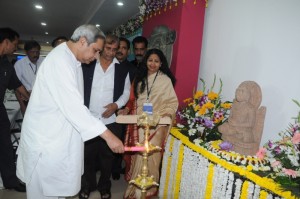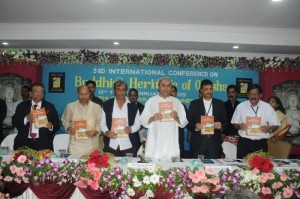 Odisha has a repository of Buddhist art and heritage. The glimpses of materials remains can be seen from the various Buddhist sits spread over the state. Buddhism -the great religion had its origin in India about 2600 years back, sometime in the 6th century B.C. It emerged as a dominant force in Indian religion and culture from its birth down about the 11th -12th century A.D. and still visible in some northern parts of India. It is still prevalent in Nepal and beyond Tibet and Mongolia and in the island of Ceylon. It has spread to South- East Asia from Thailand and Myanmar in Cambodia, Laos and Vietnam, so that by modern times Buddhism became a dominant force.
Odisha has a repository of Buddhist art and heritage. The glimpses of materials remains can be seen from the various Buddhist sits spread over the state. Buddhism -the great religion had its origin in India about 2600 years back, sometime in the 6th century B.C. It emerged as a dominant force in Indian religion and culture from its birth down about the 11th -12th century A.D. and still visible in some northern parts of India. It is still prevalent in Nepal and beyond Tibet and Mongolia and in the island of Ceylon. It has spread to South- East Asia from Thailand and Myanmar in Cambodia, Laos and Vietnam, so that by modern times Buddhism became a dominant force.
The XIII Rock Edict of emperor Ashok of 3rd century B.C, found at Dhauli bears the testimony that at the 8th year of his reign ,he invaded the country of Kalinga.He confesses that after there commenced in his mind an ardent desire to practice the Dharma.It ushered a new era of spiritual imperialism devoured by love. The emperor then ceased ceased to be Chandasoka or Asoka –the merciless and become Dharmasoka or Asoka of Law and proclaimed himself to be Debanampriya priyadasi or Beloved of Gods who loves all. Mayuran emperor Asoka then took Dharmayatra” or “Tours of Piety” and had built 84,000 Buddhist monuments throughout the Empire along with the footsteps of Buddha. The Buddhist monuments are Stupa, Pillars, Chaityas, Monasteries and Rock- Cut Caves, dedicated for the masters of Buddhist world regarding interpretation of the cannons preached by Buddha. Theravadi monks visited Kalinga and stayed here to propagate Buddhism and educate the monks of Odisha. Asoka built a monastery for Theravadin Monk, Tissa, at Bhojakagiri. It is believed that a large number of Buddhist Stupas were built by the emperor Asoka in Kalinga to glorify Buddhism. The monumental remains of Asokan period are now coming to lime light
Descriptions are found about Kalinga, Odvisa, Utkala, Kosala, Odra in various Pali and Sanskrit literature like Mahavamsa or Vamsa tradition, Lalitavistara, Nikayas, Suttas, Jatakas. Buddhism was flourished in early medieval Odisha, tremendously under the Bhaumakar period in 8th-9th century A.D. Most of the Buddhist settlements like Ratnagiri, Solampur, Boudh, Udayagiri, Kuruma have expanded during this period. The names Ratnagiri Mahvihara,(Ratnagiri), Singhprasta Mahavihara, Madhavpur Mahavihara(Udayagiri), Chandraditya Mhavihara (Lalitgiri), Solampur Mahavihara (Solampur) have been discovered through archaeological investigation. During this period the Tantrayana form of Buddhism was evolved and numerous Buddhist God and goddess were introduced which are found from Ratnagiri, Udayagiri,Solampur and many other places. During the rule of Bhaumakara king Subhkara Deva, a Buddhist monk Prajna visited China with an autographed Buddhist manuscript of the King.
 Recent Archaeological spade at Lalitgiri, Ratnagiri, Udayagiri, Langudi, Vajragiri, Kayama, Radhanagar, Brahmavana, Boudh where, we get large settlements and ruins of Buddhist monuments that speak volumes about the growth of Buddhism. It is only after the year 1986, the major Buddhist sites of Odisha like Lalitgiri,Langudi, Radhanagar and Udayagiri have many Monuments like Stupas,Chaityas, and Monasteries (Viharas) were discovered. The monumental remains of these sites have all the potential to attract visitors, tourists and pilgrims. It is known from recent research that these monuments were built in the historical days by the traders and monks occasionally by the kings and queens. It is the link between trade networks of Central Asia and South East Asia. The Buddhist sites not only speaks about the religion, but spreads the message of peace and brotherhood, decency and discipline, after all love and compassion for which the Buddhist heritage sites are being developed for tourism attraction by many countries and States.
Recent Archaeological spade at Lalitgiri, Ratnagiri, Udayagiri, Langudi, Vajragiri, Kayama, Radhanagar, Brahmavana, Boudh where, we get large settlements and ruins of Buddhist monuments that speak volumes about the growth of Buddhism. It is only after the year 1986, the major Buddhist sites of Odisha like Lalitgiri,Langudi, Radhanagar and Udayagiri have many Monuments like Stupas,Chaityas, and Monasteries (Viharas) were discovered. The monumental remains of these sites have all the potential to attract visitors, tourists and pilgrims. It is known from recent research that these monuments were built in the historical days by the traders and monks occasionally by the kings and queens. It is the link between trade networks of Central Asia and South East Asia. The Buddhist sites not only speaks about the religion, but spreads the message of peace and brotherhood, decency and discipline, after all love and compassion for which the Buddhist heritage sites are being developed for tourism attraction by many countries and States.
Let, the world know this historical truth for which this International Conference is being organized and Tourism is the medium for its promotion. We hope the serene and sublime landscape of our Buddhist sites will hit the Tourism market of the world and our this new product could draw the attention of tourism marketers. The Tour Opertaors and Travel Agencies should come forward to market it.
The 3rd International Conference is being organized by the Department of Tourism from 13th to 15th February 2015.Many professors from Japan, University of Delhi, Banaras Hindu University, Lucknow University together with Tour Operators from Delhi and Banaras along with scholars and Tour Operators of Odisha are participating in the conference.
The programme has been divided into three sessions on 1st day i.e interaction and presentations on Buddhist Sites of India and Odisha, tourism potentials of our Buddhist sites,Case Studies and Market modules will be discussed and an action plan will be prepared. The second day will be a field visit to Lalitgiri, Udayagiri and Ratnagiri –The Dimond Triangle to see the Buddhist remains that speak volumes about the great cultural background and carry forward the message of cultural integrity. There will be an exclusive B2B session for the Tour Operators on 3rd day which will help the Tour operators to bring tourists.
On 13th evening at 6 P.M, there will be a cultural programme at Rabindra Mandap.The cultural programme consisting of release of Audio CD “ Deha Videha” –the songs of medieval Buddhist monks.The song is composed by renowned singer Mrs Sasmita Das who will sing the song live. The song is written by Haraprasad Das. Next, the Sri Lankan cultural Troup will perform the cultural programme to mark the occasion.
There will be an exclusive Photo Exhibition on the Buddhist Heritage of Odisha organized by Odishan Institute of Maritime and South East Asian Studies (OIMSEAS) in the conference venue which high highlight the recent discoveries and the glimpses of Buddhist Heritage.
